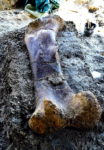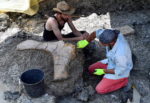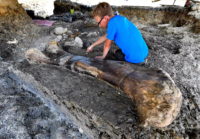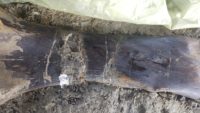 The massive thigh bone of a sauropod has been found in France. Researchers from the National Museum of Natural History in Paris discovered the femur at the paleontological site of Angeac-Charente near Chateauneuf-sur-Charente in southwestern France. Unearthed in a thick layer of clay, the bone is in excellent condition. It is 140 million years old, 6.5 feet long and weighs 500 kilos (1100 lb), as much the average horse. A large pelvic bone was also found in the same clay layer near the femur.
The massive thigh bone of a sauropod has been found in France. Researchers from the National Museum of Natural History in Paris discovered the femur at the paleontological site of Angeac-Charente near Chateauneuf-sur-Charente in southwestern France. Unearthed in a thick layer of clay, the bone is in excellent condition. It is 140 million years old, 6.5 feet long and weighs 500 kilos (1100 lb), as much the average horse. A large pelvic bone was also found in the same clay layer near the femur.
Ronan Allain, paleontologist at the Natural History Museum in Paris, added: “We can see the insertions of muscles and tendons, scars.
“This is a very rare find as large pieces tend to collapse on themselves, to fragment.”
 Angeac-Charente is the richest site of dinosaur fossils in the country, with more than 7,500 bones found there from an estimated 45 different species of dinosaur since excavations began in 2010, including bones from stegosaurs and a herd of ostrich-like dinosaurs. In addition to whole fossils, more than 66,000 bone fragments have been found there, as well as plants and dinosaur footprints. The site is near the vineyards of Cognac where the famed eponymous brandy is produced, but in the Jurassic the area was a marshland, ideal conditions for capturing, preserving and mineralizing the bones of gigantic animals and other organic remains.
Angeac-Charente is the richest site of dinosaur fossils in the country, with more than 7,500 bones found there from an estimated 45 different species of dinosaur since excavations began in 2010, including bones from stegosaurs and a herd of ostrich-like dinosaurs. In addition to whole fossils, more than 66,000 bone fragments have been found there, as well as plants and dinosaur footprints. The site is near the vineyards of Cognac where the famed eponymous brandy is produced, but in the Jurassic the area was a marshland, ideal conditions for capturing, preserving and mineralizing the bones of gigantic animals and other organic remains.
 Sauropods first appeared in the Triassic, but became widespread in the Late Jurassic period. They are the largest known herbivorous dinosaurs are among the largest animals ever to roam the earth. The femur is so large that it will take a week to recover and require a crane to raise.
Sauropods first appeared in the Triassic, but became widespread in the Late Jurassic period. They are the largest known herbivorous dinosaurs are among the largest animals ever to roam the earth. The femur is so large that it will take a week to recover and require a crane to raise.
 National Museum of Natural History paleontologists are working to reconstruct a sauropod skeleton from the fossils recovered at Angeac-Charente. So far they have more than 50% of a complete sauropod, a composite of bones from several individual specimens unearthed at the site.
National Museum of Natural History paleontologists are working to reconstruct a sauropod skeleton from the fossils recovered at Angeac-Charente. So far they have more than 50% of a complete sauropod, a composite of bones from several individual specimens unearthed at the site.